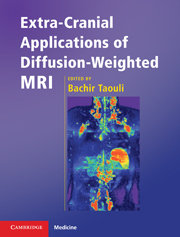Book contents
- Frontmatter
- Contents
- List of contributors
- Preface
- 1 Basic physical principles of body diffusion-weighted MRI
- 2 Diffusion-weighted MRI of the liver
- 3 Diffusion-weighted MRI of diffuse renal disease and kidney transplant
- 4 Diffusion-weighted MRI of focal renal masses
- 5 Diffusion-weighted MRI of the pancreas
- 6 Diffusion-weighted MRI of the prostate
- 7 Breast applications of diffusion-weighted MRI
- 8 Diffusion-weighted MRI of lymph nodes
- 9 Diffusion-weighted MRI of female pelvic tumors
- 10 Diffusion-weighted MRI of the bone marrow and the spine
- 11 Diffusion-weighted MRI of soft tissue tumors
- 12 Evaluation of tumor treatment response with diffusion-weighted MRI
- 13 Diffusion-weighted MRI: future directions
- Index
- References
10 - Diffusion-weighted MRI of the bone marrow and the spine
Published online by Cambridge University Press: 10 November 2010
- Frontmatter
- Contents
- List of contributors
- Preface
- 1 Basic physical principles of body diffusion-weighted MRI
- 2 Diffusion-weighted MRI of the liver
- 3 Diffusion-weighted MRI of diffuse renal disease and kidney transplant
- 4 Diffusion-weighted MRI of focal renal masses
- 5 Diffusion-weighted MRI of the pancreas
- 6 Diffusion-weighted MRI of the prostate
- 7 Breast applications of diffusion-weighted MRI
- 8 Diffusion-weighted MRI of lymph nodes
- 9 Diffusion-weighted MRI of female pelvic tumors
- 10 Diffusion-weighted MRI of the bone marrow and the spine
- 11 Diffusion-weighted MRI of soft tissue tumors
- 12 Evaluation of tumor treatment response with diffusion-weighted MRI
- 13 Diffusion-weighted MRI: future directions
- Index
- References
Summary
Introduction
Diffusion-weighted magnetic resonance imaging (DWI) is a well-established magnetic resonance imaging (MRI) technique, in which the MR signal intensity is influenced by the self-diffusion, i.e., the microscopic stochastic Brownian motion, of water molecules caused by the molecular thermal energy. An overview of the physical principles of diffusion and DWI is given in a separate chapter, and elsewhere. DWI can provide information about the microscopic structure and organization of biological tissues and, thus, can depict various pathological changes of organs or tissues. It has been thoroughly evaluated for a multitude of neurological pathologies such as brain tumors, abscesses, or white-matter diseases, and in particular for the early detection of cerebral ischemia, which is generally considered the most important application of clinical DWI.
Significantly fewer studies have been published about diffusion MRI outside the brain, mainly because of the relatively low robustness of conventional DWI methods in non-neurological applications and, consequently, the rather limited image quality in such applications. This situation, however, improved significantly in recent years due to better MRI hardware as well as newly developed pulse sequences; as a consequence, several new applications of DWI have been described. Examples such as DWI studies of the liver, the kidneys, or of soft-tissue tumors are described in detail elsewhere in this book. Recently, whole-body DWI was proposed to improve the detection of malignancies and pathological lymph nodes. Most of these applications are based on variants of the diffusion-weighting echo-planar imaging (EPI) pulse sequence.
- Type
- Chapter
- Information
- Extra-Cranial Applications of Diffusion-Weighted MRI , pp. 144 - 161Publisher: Cambridge University PressPrint publication year: 2010



